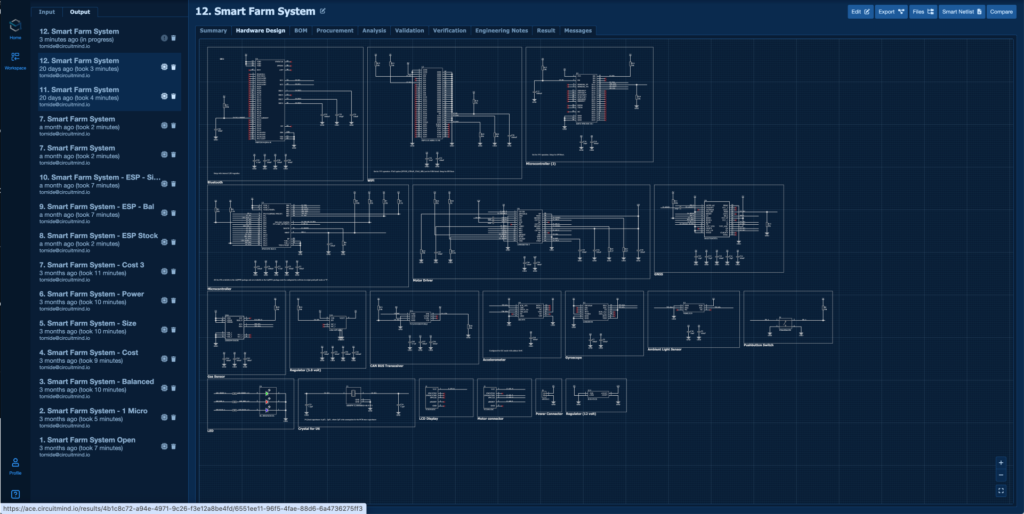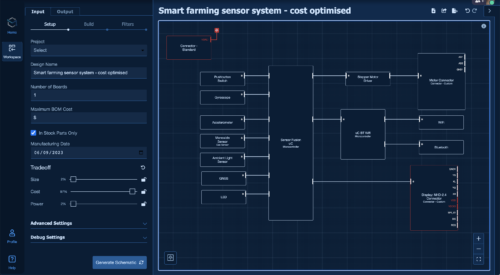by Tomide Adesanmi, CEO, Circuit Mind.
Electronic engineers are reaping the rewards from the AI wave.
In 2022, ChatGPT took the world by storm, heralding humanity’s irreversible march towards a future where AI will pervade our daily lives. Since then, we’ve witnessed the rapid progress of this frighteningly remarkable technology for use cases such as copywriting, image generation, software co-pilots, and—more recently—crisp, lifelike, video generation.
Before we dive into the details of how AI has created a new electronics design paradigm shift, let’s take a stroll down memory lane.
When I was an electronic systems engineer at BAE Systems, I lived my dream. I grew up aspiring to be an inventor and I ended up developing high integrity augmented reality (AR) display systems for jet fighter pilots alongside some of the most brilliant engineers on Earth.
However, something was missing…
In my role, I spent 80% of my time on tedious, routine tasks: poring over extensive datasheets, flitting across manufacturer websites with dozens of open tabs, solving combinatorial puzzles to map functionality and decide pin assignments across devices, talking to FAEs about the most cutting- edge parts, scrutinising component availability across various distributors… you get the picture.
The worst part: Anxiety. Anxiety that I’d overlooked a crucial detail buried in a datasheet, which could lead to an unplanned re- spin. Anxiety over selected components becoming unavailable. Anxiety that my component and design choices could be called out during a design review for not being cost effective, power efficient, size optimised, or performant enough for
our goals. Anxiety…
I quit my job at BAE Systems in 2018 because I believed in the possibility of a more effective solution that could enable electronics teams to do their best work without unnecessary anxiety. At that time, the most significant attempt at automation by the “powers that be” (existing ECAD vendors) were autorouters, which are a comprehensive failure from the vantage point of many engineers.
The state of circuit board design today is not dissimilar to the state of IC design in the 1980s, where the primary design mechanism involved datasheets, schematic capture, and layout design. When Synopsys developed the first logic synthesis engines that could take functional information in the form of HDL languages and output a logical design implementation in terms of logic gates, IC design productivity exploded, Moore’s law took root, and IC designers became the beneficiaries of a Cambrian Silicon Explosion that led to higher value jobs and more lucrative salaries. I believed we could develop technology having a similar effect for board-level electronic engineers.
Then I met Basilio, just as he completed his PhD in Algorithm Design from ETH Zurich. With Basilio’s algorithm design background and my electronics design experience, we rallied around a vision to develop algorithms that could act as a true partner to electronic engineers. Algorithms to remove the anxiety and handle the tedium whilst unleashing the unbridled creativity of electronic engineers on the hardest, most stimulating problems, allowing them to bring life- changing, reliable products to reality. This was how Circuit Mind was born—to develop advanced algorithms for professional electronic engineers and leaders.
A year ago, the first professional engineers started using the Circuit Mind platform, ACE (Assistant to Circuit Engineers). Today, professional engineers spanning various sectors— EMS, Design Services, Industrial, Consumer, Automotive, and Medical industries—use the platform to bring real automation into their workflow.

So how does it work? ACE allows an engineer to go from Architecture to Schematic in 60 seconds. Engineers specify their requirements as a block diagram, detail their specifications more granularly, and—with a single click—generate cost-effective, power efficient, small form factor schematic and BoM options in 60 seconds. ACE also optimises for lifecycle status, supply chain resilience, and preferred manufacturers.
With this methodology, it’s important for the engineer to have control. They must be able to specify their requirements as precisely as they need. For example, they should be able to specify the resolution of an accelerometer, the luminous intensity of an LED, the manufacturer of a motor driver, or even the specific part number of a microcontroller. The underlying principle is flexibility: stay at a high level of abstraction if you want or specify your design-intent in meticulous detail—it’s up to you.
Every project is unique, so the engineer should be able to specify tradeoffs like cost, size, power consumption, component availability, lifecycle status and supply- chain. The engineer should also be able to generate several design alternatives, compare the results against each other, and iterate on the outcomes to find the ideal optimised BoM and initial schematic design that suits the project’s needs, thereby leading to an optimal solution.
ACE is designed to be precise, for professional engineers who NEED to be precise. Its algorithms are built on solid fundamental circuit design principles crafted to operate alongside an engineer as a trustworthy source of options, results, and outcomes. No statistical guesses or hallucinations. No noise. No anxiety. No gimmicks. ACE is also designed to work seamlessly with an engineer’s ECAD tool. The ECAD tool is the record of your complete design, so ACE provides outputs that are editable by the engineer in their ECAD software of choice—schematics, BoMs, symbols, libraries, and all.
Finally: the big question: Does this technology replace electronic engineers? Bluntly, anyone who thinks that this or any other automation/AI- driven system could replace electronic engineers does not know what electronic engineers really do daily. ACE helps electronic engineers automate and optimise routine tasks, allowing them to spend more of their time on the more creative parts of a design as well as the “last mile” decisions that demand an engineer’s experience and human intuition. Suppose you’re an engineer who does 10 circuits/year. Deterministic AI can do 0 circuits/year alone. But you + deterministic AI can do 100 circuits/year together.
At a time when the electronic engineering industry is increasingly facing a skill shortage, a non-trivial number of skilled engineers are nearing retirement, while demand for new electronics skyrockets with the IoT, AI, and electrification waves. It is critical for civilisation that we equip every engineer on earth with the ability to do more with their time. Electronic devices power our world and the people who develop them need as much help as they can get to meet the demand that we are placing on them.
In the years ahead, we will need technologists, engineering leaders, and engineers to rally around one mission: 100x the life’s work of every single electronic engineer to drive humanity forward.

